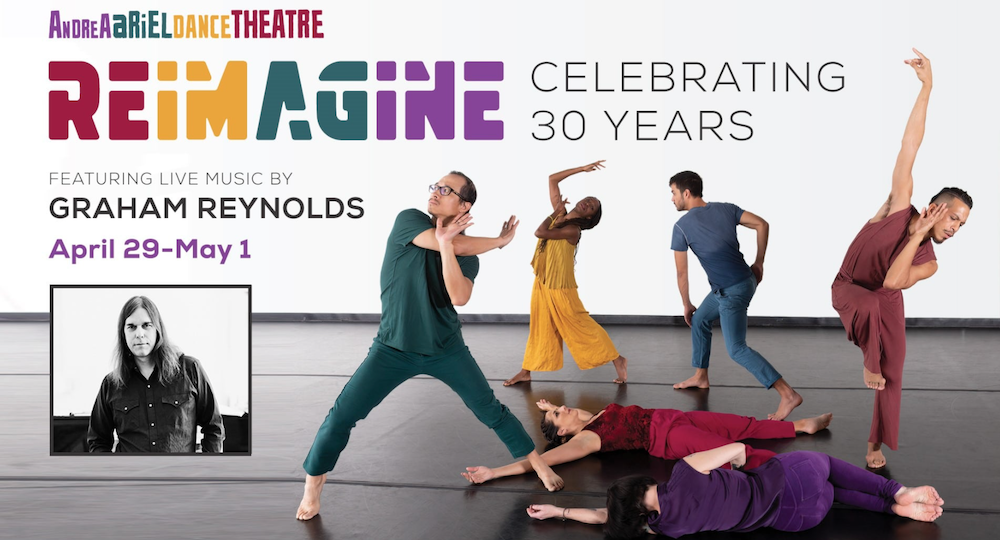Review: REIMAGINE: Celebrating 30 Years by Andrea Ariel Dance Theatre
by David Glen Robinson
What does it mean to reimagine? To imagine again, after having imagined a thing once? What does that mean? Stepping through the door to imagination, that some think of as a storage closet door, one revisits the private universe that everyone has, colored with the crayons of childhood memories, dream fragments, visions, epiphanies, ambitions, primal fears, and the pixillating disintegration of lost passions. Yes, the imagination vault can be bright and creative, but it is not your happy place. And reentering necessarily requires a bold step.

In the Andrea Ariel Dance Theatre (AADT) show Reimagine, just completed at the Long Center, we have seen the results of one artist’s bold steps into the vault. We have seen a young dancer holding part of a jigsaw puzzle of clowns and a street urchin joy-dancing her woundings and fears and hopes. And we have seen groups of imaginative figures reaching outward in abstract transcendence. Andrea Ariel has done what not all folks can do, and that is to step into the vault and bring back the ephemera and fragments of an artistic life. She has brought them into materiality once more, fully fleshed and rearticulated into new visions.
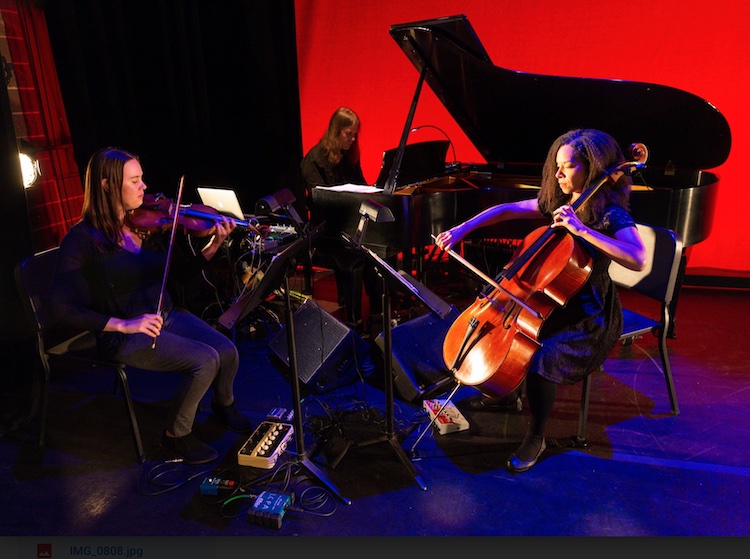
This is not dusted-off repertory. It is dance and musical performance wrapped in insistent, yearning creativity that pulses with the cycles of the seasons and renews continually while life abides. Composer Graham Reynolds offers his marvelous music as part of the newness, with a string section consisting of Alexis Buffum (violin) and Ilia de la Rosa (cello).
The freshness of renewal was seen in the first offering of the show, “Broken Head,” first created as a solo by Ariel and performed in 1990 at the Capitol City Playhouse. The piece was inspired by music by Brian Eno and others, and it captured 90's youth street life with all its pain and hope, uncertainty and risk. That’s all still in it, including the powerful gestures to the head and the improbable but sure balances of the original. Reynolds’ new music for it contained an introductory phrase for its sections that seemed to sing “broken head” in musical tones. Ceci Proeger performed the solo with all the athleticism and skill of the original until it morphed into the group work of the street gang ensemble. In an act of sheer bravura, a side-by-side video (available on Vimeo) of the original and new solos, produced by Colin Lowry, played on TV monitors in the lobby (along with additional video montages). Part of it is also currently available behind a link on the promotional e-mails in advance of the show.
“Getting Dressed” is a literally titled transition piece, one in which the ensemble brought out costume pieces, set them out, and ceremoniously tried them on. They were costuming themselves for the following piece, “Life’s a Circus,” and showing their devotion to sight-gag humor.

“Life’s a Circus,” first performed in 1996 in the show Proto, is a piece that must certainly be resurrected from the archives of a thirty-year oeuvre. The ensemble was entirely new, of course, but the performers in it were equally or more highly competent. The new were Luis Ordaz Gutiérrez, Sadé Jones, Clay Moore, Whitney O’Baugh, and Ceci Proeger. The aforementioned costumes were highly mismatched primary color and glitter-shiny garments worthy of a clown troupe, exactly what the dancers portrayed. Pam Friday designed the new dance-abstracted clown garb and all the costumes in Reimagine. The dance movement did not slack from athleticism, and the performers substituted goofy dancer faces for goofy clown maquillage. The piece drew out rare talents in the ensemble, and its humor succeeded generously.
Jun (Sunny) Shen changed the mood dramatically with his own guest choreography, “Echo of Silence.” The solo piece is new work,apparently not produced within the AADT orbit but welcomed into it. With his movements, a tatami mat, wooden blocks, and a roll of paper towels, Sunny performed a deep meditation and several prayers. And then he directed himself and all of us to the mystery of the universe. Reynold’s “Shadow and Seeing,” first composed for AADT’s Geometry of Proximity, added a beautiful and well-matched textural layer to Jun Shen’s work. Ilia de la Rosa’s cello solo was a section of sheer tonal perfection in the piece, followed by the exquisite elegance of Alexis Buffum’s violin solo in the same dance. “Echo of Silence” was one of the most beautiful composite fine arts works one could witness live in any theatre currently. One hopes the piece can find additional life in future shows.
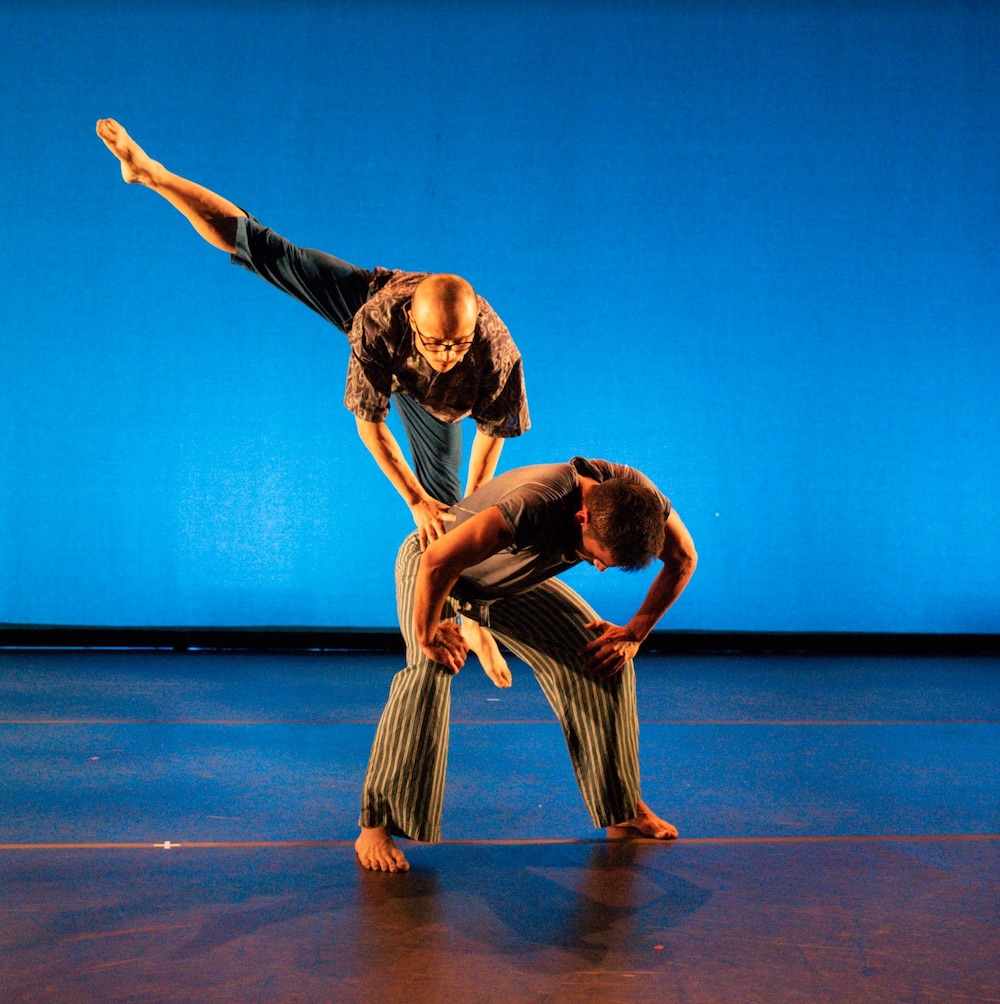 “Stripping Away” was another ensemble transition piece that gave the audience a little breather before the powerful duet of “Meeting in the Hallway,” originally performed in Five.Two.Ten. in 2008 and reimagined at least once since then. Dancers Clay Moore and Jun Shen enacted a relationship between men, met in a hallway, who agree, conflict, harmonize, and finally find common purpose. The piece was impressive for the athletic talents and smooth dance movement, flexibility, and gestures of the performers in executing challenging lifts and balances.
“Stripping Away” was another ensemble transition piece that gave the audience a little breather before the powerful duet of “Meeting in the Hallway,” originally performed in Five.Two.Ten. in 2008 and reimagined at least once since then. Dancers Clay Moore and Jun Shen enacted a relationship between men, met in a hallway, who agree, conflict, harmonize, and finally find common purpose. The piece was impressive for the athletic talents and smooth dance movement, flexibility, and gestures of the performers in executing challenging lifts and balances.
“Breathing Breath” originally was a duet between Andrea Ariel and Steve Ochoa in 2008’s Five.Two.Ten. The piece was reimagined here as a duet between two women, Ceci Proeger and Whitney O’Baugh. The gender rearrangement was exploratory and intentional, and further play with gender identification was made subtly with costume statements—not quite male, not quite female. This new version allowed a clear view of gender-equal lifts and carries that existed in the original but may not have been apparent at the time. Proeger and O’Baugh are exquisite talents making auspicious returns to AADT. The original dance was the one about which Ariel delivered her key quote: “(it was the dance that) has always been one of those things that happen that allow new things to happen.”
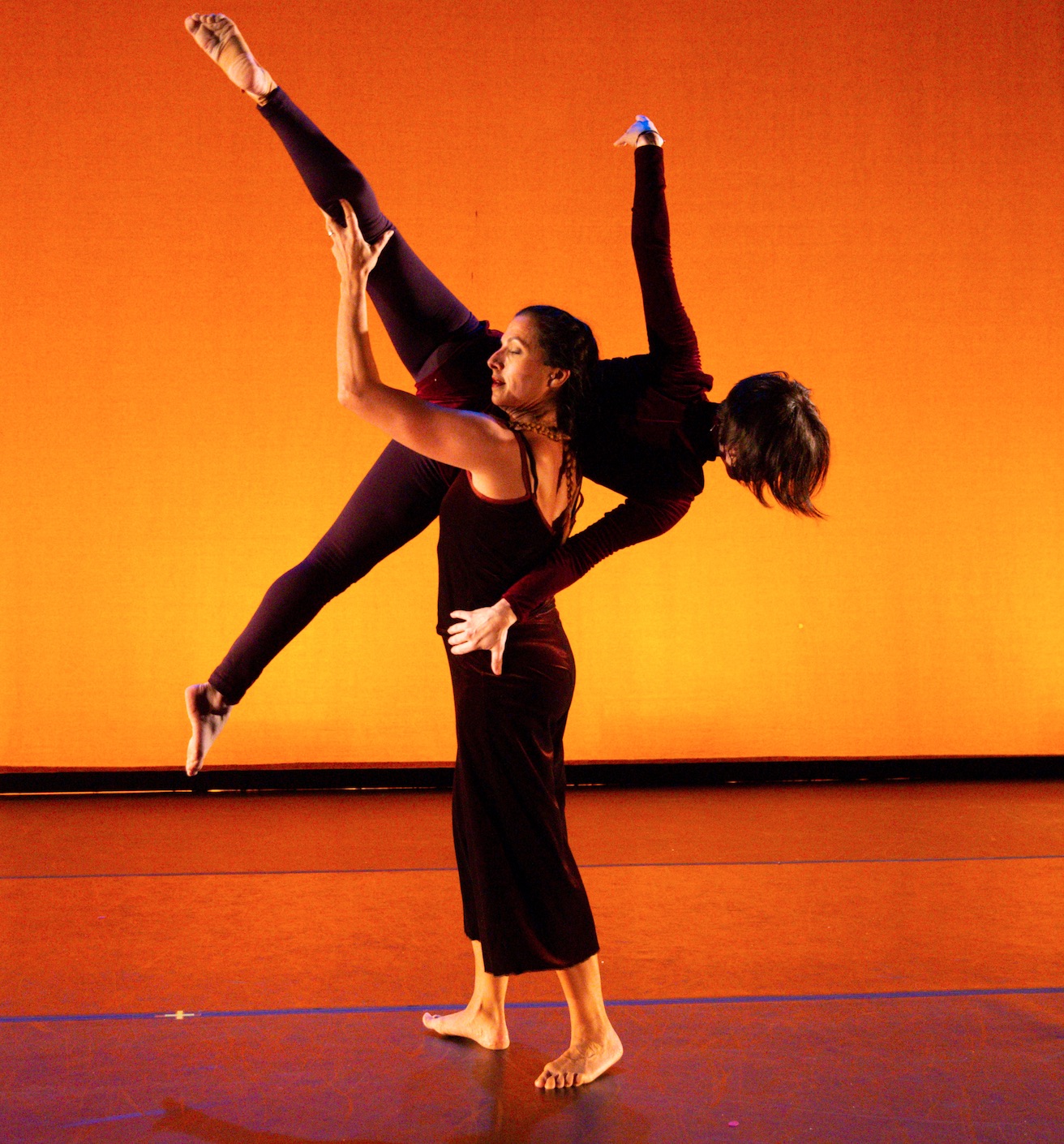
The last three pieces in the show, “Outside Self,” “Home,” and “Moving Forward Together” were linked to build movement into a grand statement calling for social unity and awareness, a leitmotif of Ariel’s work since at least 2001’s 7 Rooms to the Soul (though the three pieces here date no earlier than 2012). Sadé Jones and Luis Ordaz Gutiérrez literally set the stage for the linkages with their flowing movements and exquisite timing. They and the ensemble moved the piece forward to an envisioned new social contract. This future seemed built on depicted vivid dreams well expressed by each of the dancers in “Moving Forward Together.” The dreams were suggested as guides into the future. After this was established, the dancers descended to the floor in stillness as the lights dimmed but did not go out. Then, slowly, the dancers rose individually to waking life, daytime lighting, and returned to movement with idiosyncratic gestures and shapes, moving in pedestrian fashion and looking at each other with curiosity and openness. They seemed to be seeking opportunities and bonds with each other to move into a beneficent future. The show ended at this point.
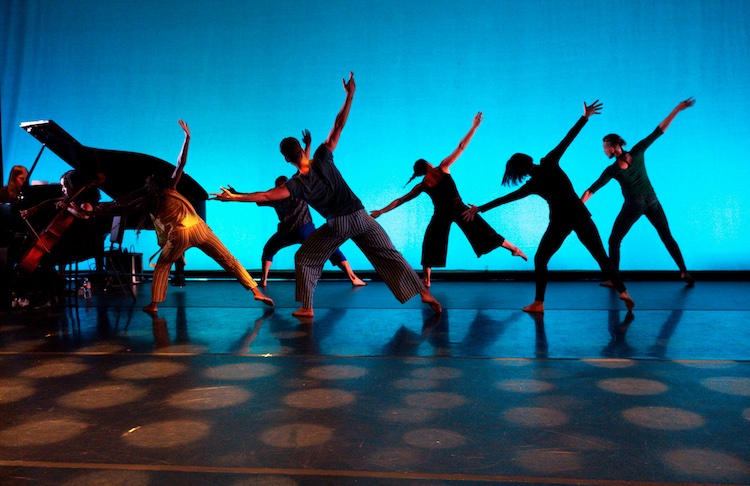
Graham Reynolds’ music is full of reimaginings of his own work over the fourteen years he has worked with Andrea Ariel. As Ariel comments in her curtain speeches, “Graham’s work has had touchpoints with my work.” The connections and influences go both ways. In Reimagine, music by Reynolds and Buffum and de la Ros created a full score that could stand alone in any number of media, and perhaps it shall. Reynolds’ concerti, soundtracks, and other musical forms are wide-ranging and therefore truly uncategorizable. His pieces commonly feature original and minor key melodies, bass lines and much percussion, and they never fail to honor the intense beauty of all music.
It must be noted as a matter of high full disclosure that this reviewer has the distinct and possibly unique honor to been an eye witness to live performances of both the original and newly reimagined pieces in this show. The cascades and memory riffs are tidal in their volume, and they provide, for me and others with similar experience of AADT, touchpoints with our own histories. These touchpoints spark reveries of where we were in 1990 or 1996 or whenever, and evoke our hopes, dreams, and ambitions. In this quality, in part, lies Andrea Ariel’s artistic gift to the world. As she modestly put it in the preview article in CTXLT.com, “As I have come back to the creative process in-person with the dancers two years later, a deeper meaning of the work has emerged. It reflects our experience of the changes we have gone through. This collection of dances draws together threads that find relevance in our current times.” It goes for all times, too.
The acts and processes of reimagining such bright artwork are difficult creative explorations. This acknowledgement recalls T.S. Eliot's declaration: “We shall not cease from exploration, and the end of all our exploring will be to arrive where we started and know the place for the first time.”
REIMAGINE: Celebrating 30 Years
by Andrea Ariel, Graham Reynolds
Andrea Ariel Dance Theatre
April 29 - May 01, 2022
April 29 - May 1, 2022
Rollins Theatre, Long Center, Austin
Reserved seats $39 + $6.75 Long Center fee: $45.75
General admission $29 plus fee; discounted rate $19 plus fee for seniors, physically disabled, others, plus fee.
Click HERE to go to the Long Center for tickets to REIMAGINE.
